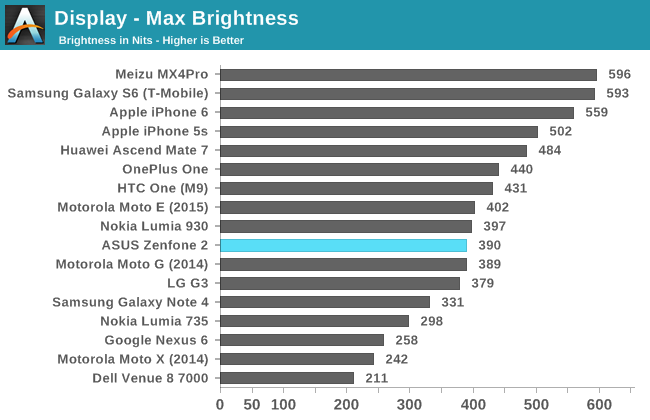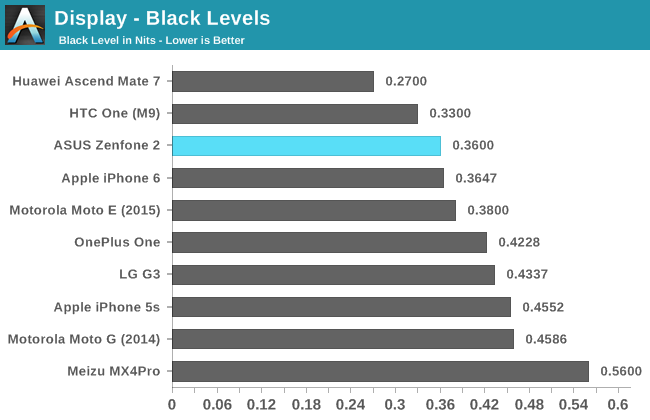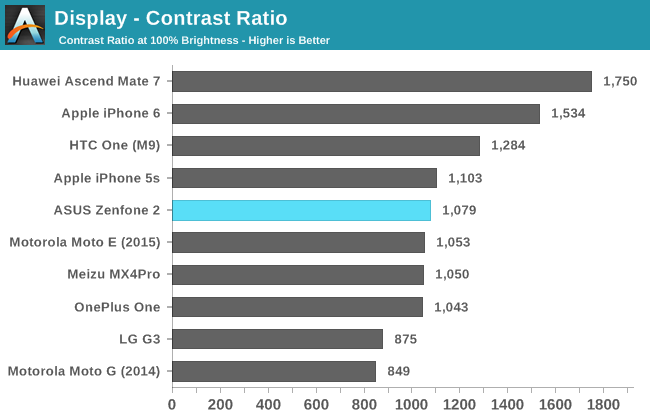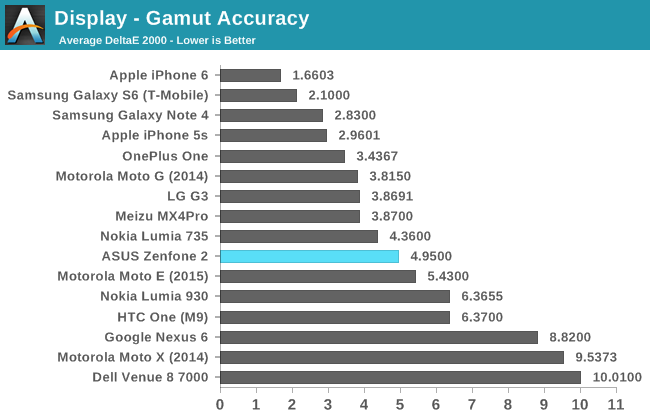The ASUS ZenFone 2 Preview
by Brandon Chester on May 18, 2015 2:00 PM ESTDisplay
I thought it would be important to give potential buyers some idea of how good the display is on the ZenFone 2. On paper it looks very good, as it's a 5.5" 1920x1080 IPS display. The pixel density isn't as high as the latest generation of 2560x1440 panels, but I find that with an RGB stripe panel the difference between 1920x1080 and 2560x1440 is minimal even at 5.5".


The ZenFone 2 appears to be off to a good start. Black levels are very low among our LCDs, and the max brightness is somewhat low but not terrible by any means. I never had any issues when using the ZenFone 2 outside, although it was definitely not as comfortable as the Galaxy S6.

The slightly low max brightness and above average black level results put the ZenFone 2 right in the middle of our LCD devices when it comes to contrast ratio.
Unfortunately, these numbers are somewhat misleading. This is because the ZenFone 2 makes extremely heavy use of dynamic contrast and contect adaptive backlighting. I have never used another device with such dramatic shifts in backlight power. The best example I've found is when switching from an all black to all white screen at max brightness. While this is obviously an extreme case, it illustrates the behavior that is occuring very well. At the moment you switch to white, the brightness of the display is around 170 nits. Over the next few seconds, that brightness rapidly increases to the 390 nits you see in the results above. This is an enormous jump in brightness, and it's very easy to see with your own eyes.
One last thing I'd like to note about the brightness is that the 100% setting on the built in brightness slider is not actually the max brightness that the display is capable of. The max you can achieve using the slider in the Settings app is 319 nits, which is around 82% of the 390 nit result you can get using applications like Brightness Adjuster from Google Play.

The gamut results are unfortunately not as good as what we've seen from the latest generation of smartphones. The DeltaE for red, blue, and magenta are all just over three, while the remaining three colors are around five. The high error in white also contributes to the higher than optimal overall error.
The complete review of the ZenFone 2 should be posted in the near future, and it will include the remainder of our display workflow. The heavy use of CABC and dynamic contrast has a large impact on the display's performance in some of our tests, and so I'll also be elaborating on where and why that occurs, and what it means for the user. For anyone who really wants to order the ZenFone 2 now, I'll conclude by saying that it's definitely not perfect, but it's still a good display. I think it's by far the nicest one you'll find on a phone that starts at $199 purely because of its resolution.











139 Comments
View All Comments
appliance5000 - Monday, May 18, 2015 - link
You do have to aim them.LuxZg - Monday, May 18, 2015 - link
Please test GPS as well! I'm very interested how this phone's hardware compares in that area to MediaTek's "China phones" (which usually suck in lock times and accuracy). Thanks! :)danielfranklin - Monday, May 18, 2015 - link
Does anyone feel this would be a much more interesting phone if it had a high end ARM based SOC?I love Intel and ASUS and all but the thought of running into compatibility issues with software really isnt very appealing....
MikhailT - Monday, May 18, 2015 - link
For the price, I would rather bitch at the developers and Google to support these Intel SoCs sooner.Software compatibility is easier to fix than hardware. For Google, they don't care about who wins in the end (Intel vs. Arm), they just want Android to the best software.
That's why competition is great, these devices are something I can afford to give my whole family. Most of us are 2-3 year old devices and plan to stay another year. Can't wait for Zenfone 3 (also ZenBook Pro with Skylake/Cannonlake).
MikhailT - Monday, May 18, 2015 - link
Blah, I wish I can edit my posts.Arm > ARM
best software > best mobile OS platform.
kenansadhu - Monday, May 18, 2015 - link
Next zenbook pro ftw!lilo777 - Monday, May 18, 2015 - link
In what way would such phone be more interesting? There are plenty of very similar phones with high end ARM SOCs. This one has unique SOC and this is what makes it interesting. While we do not know for sure but the phone price is probably low in part due to Intel selling their SOCs dirt cheap.Frihed - Wednesday, May 20, 2015 - link
This one is x64 and have 4gb RAM (with mean future proof for android 6), also it's dual chip, with at least for me is a big deal.tipoo - Monday, May 18, 2015 - link
With Intels contra-revenue program, Asus only pays 5 dollars per SoC, Intel takes a loss on each chip. No ARM chip costs that little, and definitely not at 5 bucks. It's part of what allows the good performance at such a low price.yangsta - Monday, May 18, 2015 - link
Is the 2.3mhz version worth paying the extra $100 for over the 1.8mhz version? What do you guys think? That's 50% more!